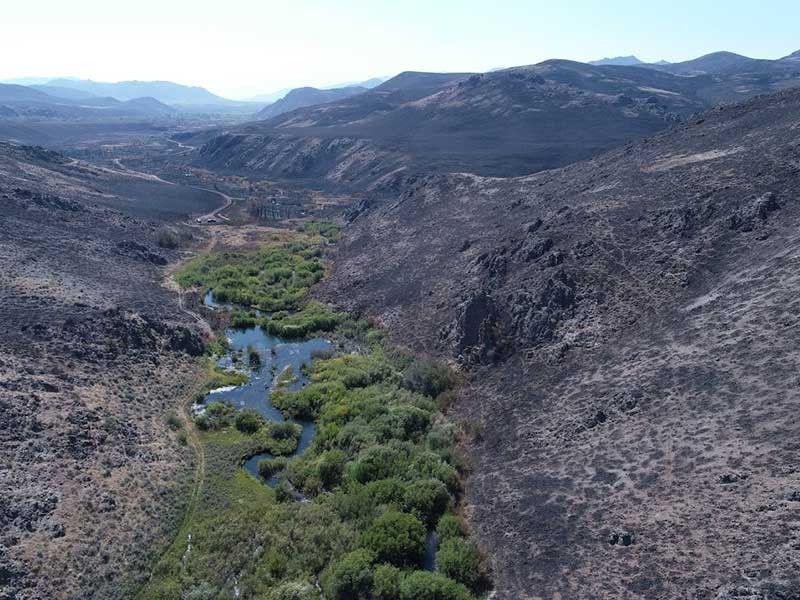QCNR Professor Teaches Low-Tech Solutions for Healing Streams after Fire
By Traci Hillyard |
North American Beaver from Spawn Creek. (Credit: Kenny DeMeurichy/Utah State University)
Joe Wheaton and colleagues are doing less and less for stream restoration, and people are starting to notice.
Wheaton, Associate Professor and Fluvial Geomorphologist in Utah State University’s S.J. and Jessie E. Quinney College of Natural Resources, is studying low-tech restoration approaches for healing degraded streams in the arid west. Rather than relying on more intense solutions – heavy equipment and big budgets – to improve these waterways, he’s teamed with conservationists … and hopefully beavers … to use cost-effective, low-tech strategies that can scale up to the scope of degradation.
Simple techniques like weaving branches through posts to mimic beaver dams, placing clumps of wood debris to slow channel flows and building stone features to reduce erosion are low-cost, easy-to-implement fixes that Wheaton and collaborators hope will both kick start natural recovery processes and encourage beavers to move back into areas affected by wildfire. Those collaborators include ranchers, the Natural Resource Conservation Service, U.S. Fish & Wildlife Service, Bureau of Land Management, U.S. Forest Service, Idaho Department of Fish & Game, Utah Division of Wildlife Resources, Utah Watershed Restoration Initiative, The Nature Conservancy, a growing army of practitioners and many others.
These ideas were recently featured by the National Wildlife Federation as a strategy that poses less risk, is less expensive, and is easier to implement than traditional projects – at what is often less than one-tenth the cost. Low-tech techniques have the potential to push streams toward natural recovery with very little financial investment or physical work, Wheaton said. “People are really excited after seeing these low-tech structures in action. You can turn a trickle into a pond after one day’s work,” he said. “It seems like a magic trick, but it’s really just a matter of changing up the timing of how long water sticks around.”
Streams must be constantly fed … not just by water, but by dirt, rocks and wood. Slowing stream flow and adding habitat complexity using locally-sourced branches, rocks, and turf makes them more attractive to animals and creates inviting habitat for plants … and can indirectly help to limit erosion that sometimes devastates an area after a wildfire. Many streams in the western U.S. are structurally starved of wood from a lack of beaver activity. Too many waterways now drain their runoff too efficiently down straightened and simplified channels to hold water in the floodplains or to create riparian habitat.
By slowing and spreading out the water with low-tech structures, soil moisture retention is boosted, water tables rise, and the area stays cooler when temperatures soar. The rich habitat provides attractive forbs and insects for birds, ungulates and other wildlife, offering them high-protein foods. It improves both surface and groundwater availability and lessens the erosive energy of floods. And by providing more attractive habitat, Wheaton hopes that beaver will be able to continue the job, especially after fire.
“We can’t dump beaver into a watershed that has burnt to the ground and expect them to do the restoration of degraded streams on their own. Maybe after some riparian vegetation has come back they can help. However, if we can get beaver in these systems, they certainly can make these systems more resilient to fire itself, as well as providing critical refugia during the fire for wildlife and even livestock.” Wheaton said. “What we can do post-fire, is accelerate recovery with low-tech structures, that make it easier to more quickly get beaver into an area and accelerate recovery. We’d like to help them do that.”
Low-tech stream restoration techniques are just starting to be explored in post-fire recovery efforts to protect and improve existing wetland habitat. The Bureau of Land Management is planning on using low-tech structures to accelerate riparian recovery and mitigate mudslides during runoff after the 2018 Goose Creek Fire in Utah.
Through teaching workshops on low-tech restoration across several states, Wheaton hopes to spread more than just the stream flow. He and the USU Restoration Consortium have partnered up with Jeremy Maestas (NRCS), Pheasants Forever and the Sage Grouse Initiative to deliver this message across the west. Their ideas and techniques are a smart, affordable, and practical strategy for wildfire recovery that’s both technically and feasibly accessible to all sorts of people interested in stream health.
“It doesn’t mean we’re going to spend less on stream restoration, it just means we can maximize that taxpayer investment to stretch those restoration dollars further to help more streams,” Wheaton said.
So even though Wheaton is actually advocating for less, thanks to him, more is getting done for stream restoration.
Following 2018 Sharps Fire 65,000 acres burned except where beavers helped with riparian vegetation.Thank you beavers! (Credit: Joe Wheaton/ Utah State University.)
WRITER
Traci Hillyard
Administrative Assistant
College of Science
435-797-2478
traci.hillyard@usu.edu
CONTACT
Joe Wheaton
Associate Professor and Fluvial Geomorphologist
S. J. Jessie E. Quinney College of Natural Resources
435-5554-1247
joe.wheaton@usu.edu
ADDITIONAL RESOURCES
- - S.J. and Jessie E. Quinney College of Natural Resources
- - What is Low-Tech Stream Restoration, SGI
- - SGI Workshop Series
- - USU Restoration Consortium
TOPICS
Research 879stories Water 260stories Ecology 173stories Wildlife 141stories Conservation 82stories Solutions 64stories Restoration 36storiesComments and questions regarding this article may be directed to the contact person listed on this page.








